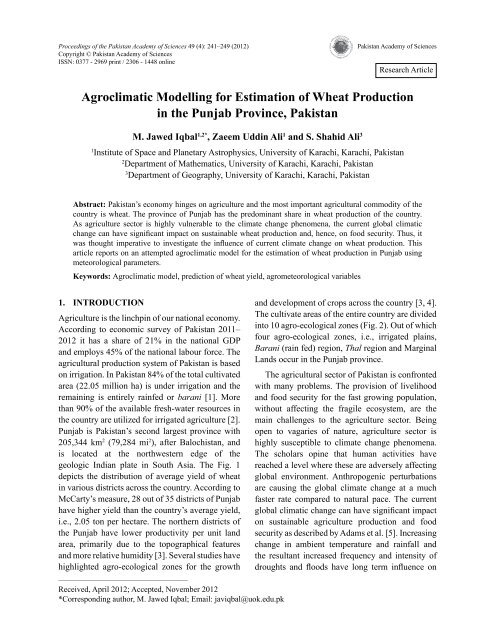Download Full Journal - Pakistan Academy of Sciences
Download Full Journal - Pakistan Academy of Sciences
Download Full Journal - Pakistan Academy of Sciences
You also want an ePaper? Increase the reach of your titles
YUMPU automatically turns print PDFs into web optimized ePapers that Google loves.
Proceedings <strong>of</strong> the <strong>Pakistan</strong> <strong>Academy</strong> <strong>of</strong> <strong>Sciences</strong> 49 (4): 241–249 (2012) <strong>Pakistan</strong> <strong>Academy</strong> <strong>of</strong> <strong>Sciences</strong><br />
Copyright © <strong>Pakistan</strong> <strong>Academy</strong> <strong>of</strong> <strong>Sciences</strong><br />
ISSN: 0377 - 2969 print / 2306 - 1448 online<br />
Research Article<br />
Agroclimatic Modelling for Estimation <strong>of</strong> Wheat Production<br />
in the Punjab Province, <strong>Pakistan</strong><br />
M. Jawed Iqbal 1,2* , Zaeem Uddin Ali 1 and S. Shahid Ali 3<br />
1<br />
Institute <strong>of</strong> Space and Planetary Astrophysics, University <strong>of</strong> Karachi, Karachi, <strong>Pakistan</strong><br />
2<br />
Department <strong>of</strong> Mathematics, University <strong>of</strong> Karachi, Karachi, <strong>Pakistan</strong><br />
3<br />
Department <strong>of</strong> Geography, University <strong>of</strong> Karachi, Karachi, <strong>Pakistan</strong><br />
Abstract: <strong>Pakistan</strong>’s economy hinges on agriculture and the most important agricultural commodity <strong>of</strong> the<br />
country is wheat. The province <strong>of</strong> Punjab has the predominant share in wheat production <strong>of</strong> the country.<br />
As agriculture sector is highly vulnerable to the climate change phenomena, the current global climatic<br />
<br />
<br />
article reports on an attempted agroclimatic model for the estimation <strong>of</strong> wheat production in Punjab using<br />
meteorological parameters.<br />
Keywords: Agroclimatic model, prediction <strong>of</strong> wheat yield, agrometeorological variables<br />
1. INTRODUCTION<br />
Agriculture is the linchpin <strong>of</strong> our national economy.<br />
According to economic survey <strong>of</strong> <strong>Pakistan</strong> 2011–<br />
2012 it has a share <strong>of</strong> 21% in the national GDP<br />
and employs 45% <strong>of</strong> the national labour force. The<br />
agricultural production system <strong>of</strong> <strong>Pakistan</strong> is based<br />
on irrigation. In <strong>Pakistan</strong> 84% <strong>of</strong> the total cultivated<br />
area (22.05 million ha) is under irrigation and the<br />
remaining is entirely rainfed or barani [1]. More<br />
than 90% <strong>of</strong> the available fresh-water resources in<br />
the country are utilized for irrigated agriculture [2].<br />
Punjab is <strong>Pakistan</strong>’s second largest province with<br />
205,344 km 2 (79,284 mi 2 ), after Balochistan, and<br />
is located at the northwestern edge <strong>of</strong> the<br />
geologic Indian plate in South Asia. The Fig. 1<br />
depicts the distribution <strong>of</strong> average yield <strong>of</strong> wheat<br />
in various districts across the country. According to<br />
McCarty’s measure, 28 out <strong>of</strong> 35 districts <strong>of</strong> Punjab<br />
have higher yield than the country’s average yield,<br />
i.e., 2.05 ton per hectare. The northern districts <strong>of</strong><br />
the Punjab have lower productivity per unit land<br />
area, primarily due to the topographical features<br />
and more relative humidity [3]. Several studies have<br />
highlighted agro-ecological zones for the growth<br />
————————————————<br />
Received, April 2012; Accepted, November 2012<br />
*Corresponding author, M. Jawed Iqbal; Email: javiqbal@uok.edu.pk<br />
and development <strong>of</strong> crops across the country [3, 4].<br />
The cultivate areas <strong>of</strong> the entire country are divided<br />
into 10 agro-ecological zones (Fig. 2). Out <strong>of</strong> which<br />
four agro-ecological zones, i.e., irrigated plains,<br />
Barani (rain fed) region, Thal region and Marginal<br />
Lands occur in the Punjab province.<br />
The agricultural sector <strong>of</strong> <strong>Pakistan</strong> is confronted<br />
with many problems. The provision <strong>of</strong> livelihood<br />
and food security for the fast growing population,<br />
without affecting the fragile ecosystem, are the<br />
main challenges to the agriculture sector. Being<br />
open to vagaries <strong>of</strong> nature, agriculture sector is<br />
highly susceptible to climate change phenomena.<br />
The scholars opine that human activities have<br />
reached a level where these are adversely affecting<br />
global environment. Anthropogenic perturbations<br />
are causing the global climate change at a much<br />
faster rate compared to natural pace. The current<br />
<br />
on sustainable agriculture production and food<br />
security as described by Adams et al. [5]. Increasing<br />
change in ambient temperature and rainfall and<br />
the resultant increased frequency and intensity <strong>of</strong>

















